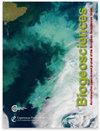Enabling a process-oriented hydro-biogeochemical model to simulate soil erosion and nutrient losses
IF 3.9
2区 地球科学
Q1 ECOLOGY
引用次数: 0
Abstract
Abstract. Water-induced erosion and associated particulate carbon (PC), particulate nitrogen (PN) and particulate phosphorus (PP) nutrient losses are vital parts of biogeochemical cycling. Identifying their intensity and distribution characteristics is of great significance for the control of soil and water loss and nitrogen/phosphorus nonpoint source pollution. This study incorporated modules of physical soil erosion and associated PC, PN and PP losses into a process-oriented hydro-biogeochemical model (Catchment Nutrients Management Model coupled with DeNitrification–DeComposition, CNMM-DNDC) to enable it to predict soil and water loss. The results indicated that the upgraded CNMM-DNDC (i) performed well in simulating the observed temporal dynamics and magnitudes of surface runoff, sediment and PN/PP yields in the lysimetric plot of the Jieliu catchment in Sichuan Province and (ii) successfully predicted the observed monthly dynamics and magnitudes of stream flow, sediment yield and PN yields at the catchment outlet, with significant univariate linear regressions and acceptable Nash–Sutcliffe indices higher than 0.74. The upgraded CNMM-DNDC demonstrated that a greater proportion of PN to total nitrogen (TN) during the period with large precipitation events and amounts than that during the drought period (16.2 %–26.6 % versus 2.3 %–12.4 %). The intensities of soil erosion and particulate nutrient yields in the Jieliu catchment were closely related to land use type in the following order: sloping cultivated upland (SU) > residential areas (RA) > forest land (FL). The scenario analysis demonstrated that high greenhouse gas (GHG) emissions scenarios provided a greater risk of soil erosion than did low GHG emissions scenarios and that land use change (i.e., from SU to FL) could help to mitigate soil and water loss accelerated by climate change in the future. The upgraded model was demonstrated to have the ability of predicting ecosystem productivity, hydrologic nitrogen loads, emissions of GHGs and pollutant gases, soil erosion and particulate nutrient yields, which renders it a potential decision support tool for soil erosion and nonpoint source pollution control coordinated with increasing production and reducing GHG and pollutant gases emissions in a catchment.启用面向过程的水文生物地球化学模型来模拟土壤侵蚀和养分损失
摘要水引起的侵蚀和相关的颗粒碳(PC)、颗粒氮(PN)和颗粒磷(PP)营养损失是生物地球化学循环的重要组成部分。识别其强度和分布特征,对控制水土流失和氮磷非点源污染具有重要意义。本研究将物理土壤侵蚀和相关的PC、PN和PP损失模块纳入了一个面向过程的水文生物地球化学模型(集水区营养管理模型与脱氮-脱氮组合,CNMM-DNDC),使其能够预测土壤和水损失。结果表明,改进后的CNMM-DNDC(i)很好地模拟了在四川省界流流域测渗图中观测到的地表径流、沉积物和PN/PP产量的时间动态和大小,具有显著的单变量线性回归,可接受的Nash–Sutcliffe指数高于0.74。升级后的CNMM-DNDC表明,在降水量大的时期,PN占总氮的比例比干旱时期更大(16.2 %–26.6 % 而2.3 %–12.4 %). 结流流域的土壤侵蚀程度和颗粒物养分产量与土地利用类型密切相关,其顺序为:坡面耕地(SU)>居民区(RA)>林地(FL)。情景分析表明,高温室气体排放情景比低温室气体排放情况提供了更大的土壤侵蚀风险使用变化(即从SU到FL)有助于缓解未来气候变化加速的水土流失。升级后的模型具有预测生态系统生产力、水文氮负荷、温室气体和污染物排放、土壤侵蚀和颗粒物养分产量的能力,这使其成为一种潜在的决策支持工具,用于土壤侵蚀和非点源污染控制,同时提高产量,减少集水区的温室气体和污染物排放。
本文章由计算机程序翻译,如有差异,请以英文原文为准。
求助全文
约1分钟内获得全文
求助全文
来源期刊

Biogeosciences
环境科学-地球科学综合
CiteScore
8.60
自引率
8.20%
发文量
258
审稿时长
4.2 months
期刊介绍:
Biogeosciences (BG) is an international scientific journal dedicated to the publication and discussion of research articles, short communications and review papers on all aspects of the interactions between the biological, chemical and physical processes in terrestrial or extraterrestrial life with the geosphere, hydrosphere and atmosphere. The objective of the journal is to cut across the boundaries of established sciences and achieve an interdisciplinary view of these interactions. Experimental, conceptual and modelling approaches are welcome.
 求助内容:
求助内容: 应助结果提醒方式:
应助结果提醒方式:


